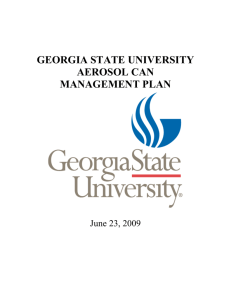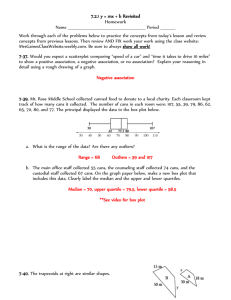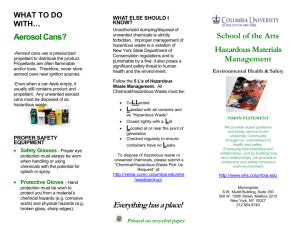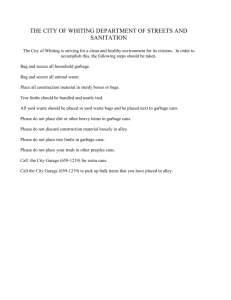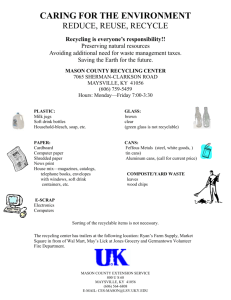105.01 Appendix 4 - Aerosol Cans - Environmental Safety and Health
advertisement
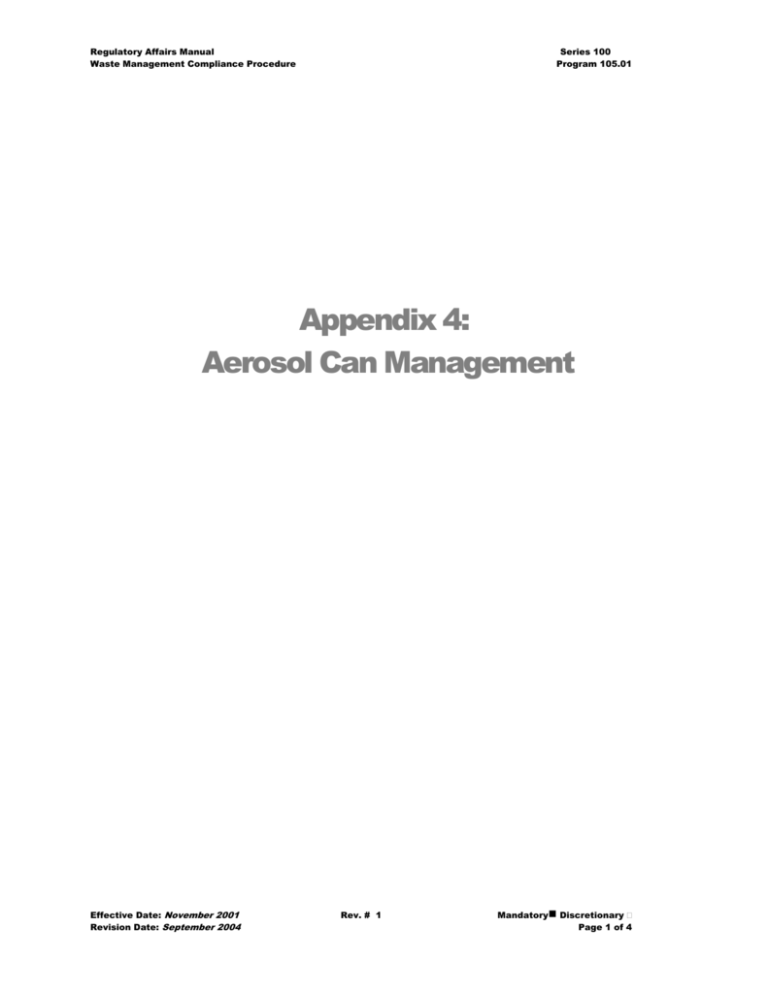
Regulatory Affairs Manual Waste Management Compliance Procedure Series 100 Program 105.01 Appendix 4: Aerosol Can Management Effective Date: November 2001 Revision Date: September 2004 Rev. # 1 Mandatory Discretionary Page 1 of 4 Regulatory Affairs Manual Waste Management Compliance Procedure Series 100 Program 105.01 REGULATORY AFFAIRS DEPARTMENT ENVIRONMENTAL REGULATION OVERVIEW DISTRIBUTION: R. Blum, B. Chase, D. Engle, D. Fitzgerald, B. Fuhrer, M. Jasko, A. Kellogg, B. Knighton, H. Lachhman, A. Ozolins, C. Shreckengost, J. Vaughan, E. Zalewski FROM: T. Tisa, L. Williams NUMBER: 01-004 DATE: November 7, 2001 SUBJECT: DISPOSAL OF AEROSOL SPRAY CANS OVERVIEW: The disposal of aerosol cans must be done properly to ensure that the discarded spray cans and their contents are disposed of in a manner that 1) is consistent with federal and state hazardous waste regulations and 2) is protective of the environment and health of personnel. Spray cans contain flammable propellants and listed solvents. These spray cans will exhibit the chacteristics of ignitibility and reactivity when they are not empty and are therefore hazardous waste. These cans must be managed as is all other hazardous waste generated at your facility. There is equipment available to empty the spray cans, but this activity is regulated by federal and state regulations. Aerosol can disposal is different when these cans are emptied in a residential setting rather than in an industrial one. Household waste is exempt from the hazardous waste regulations; therefore disposal of these cans is not regulated when disposed of at home. In an industrial setting, they are covered by hazardous waste regulations and employees must be trained to properly dispose of any aerosol spray can. IMPACT TO FISHER SCIENTIFIC: Both manufacturing and logistic operations generate used spray cans from painting, degreasing and lubricating processes. Persons working in Distribution centers either as contractors or as maintenance area employees use aerosol can items to perform maintenance on mobile and stationary equipment. Manufacturing plants have a need for various manufacturing aids many of which come in aerosol spray cans. All spray can usage needs to be evaluated to determine if it is truly necessary. If spray can use is necessary, then a waste classification of the material must be determined and documented. Spray can puncturing equipment can be used only if the contents of the cans are not a hazardous waste, if the cans do not exhibit a characteristic of hazardous waste, if the aerosol cans are by regulation “empty”, if the cans are being recycled through a metal recycler, AND if state requirements are met. If any of these conditions cannot be documented, then the aerosol spray can must be managed with the the site’s other hazardous waste. Effective Date: November 2001 Revision Date: September 2004 Rev. # 1 Mandatory Discretionary Page 2 of 4 Regulatory Affairs Manual Waste Management Compliance Procedure Series 100 Program 105.01 ACTION PLAN: A decision diagram for the management of aerosol spray cans is provided for your review. If your site chooses to use the spray can puncturing equipment, then a written operating procedure needs to be developed and reviewed by this office. The simplest action is to collect all aerosol spray cans and make a hazardous waste determination based on the contents of the can and the amount of liquid remaining in the can. Segregate all hazardous and non-hazardous waste aerosol spray cans. Add all hazardous waste spray cans to the other hazardous waste generated on site. Cans would need to be placed into an outer container and labeled with the words “hazardous waste” and the date of accumulation. If you have any questions or need assistance, please call Tom Tisa at (412) 490-8928 or Leslie Williams at (412) 490-8933. cc: N. Brown, E. Carfagno, J. DellaValle, B. Hundley, J. Jochims, M. Lew, K. Napier, C. Rohlmeier, D. Susa-Anderson Effective Date: November 2001 Revision Date: September 2004 Rev. # 1 Mandatory Discretionary Page 3 of 4 Regulatory Affairs Manual Waste Management Compliance Procedure Series 100 Program 105.01 Decision Diagram for the Management of Aerosol Cans 1) Do the contents of the aerosol cans contain? a) Listed hazardous waste (e.g. 1,1,1 trichloroethane, trichloroethylene or tetrachloroethylene) i) No – proceed to 2 ii) Yes – manage and dispose of as hazardous waste 2) Do the contents of the aerosol can exhibit a characteristic of a RCRA waste? a) Characteristic of ignitibility (D001) – ignitable compressed gas (e.g. propane) or flammable solvents (e.g. toluene, xylene) i) No – proceed to 2b ii) Yes - manage and dispose of as hazardous waste b) Characteristics of reactivity (D003) - “is capable of detonation or explosive reaction if it is subjected to a strong initiating source or if heated under confinement” (i.e. does any propellant remain) i) No – waste is not a RCRA waste proceed to step 5 ii) Yes - manage and dispose of as hazardous waste 3) Are the cans RCRA empty? a) Empty per common industry practices to less than 3% weight of the total capacity of the container and b) Compressed ignitable gas pressure in the container approaches atmospheric pressure and c) The empty can does not continue to exhibit the characteristic of reactivity. That is the can and it contents “is not capable of detonation or explosive reaction if it is subjected to a strong initiating source or if heated under confinement”. i) No - manage and dispose of as hazardous waste ii) Yes – proceed to step 4 4) Are the cans going to be recycled as scrap metal? a) No – manage and dispose of as hazardous waste b) Yes – empty can is considered part of the recycling process and is exempt from RCRA regulations - proceed to step 5 5) Is your facility in one of these states? a) Arkansas, Georgia, Massachusetts, New Jersey, New York i) Any waste (gas and liquid) must be treated properly as hazardous waste b) California i) Must be done by a Department of Toxic Substance Control certified technology c) Pennsylvania i) Need “permit by rule” (1) Notify PADEP (2) Treat residue waste appropriately (3) Treat “RCRA empty” cans as scrap metal d) Texas i) Residue form cans must be shipped with 90 days of removal from cans e) Wisconsin i) Need to keep records of puncturing activities (1) Detailed log on what type of waste is being captured (2) The volume being captured (3) The dates capturing was done (4) Documentation of how and when puncturing equipment is maintained Effective Date: November 2001 Revision Date: September 2004 Rev. # 1 Mandatory Discretionary Page 4 of 4

